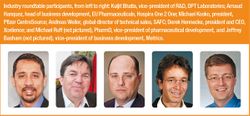Decades of Change for the Top Pharmaceutical Companies
PTSM: Pharmaceutical Technology Sourcing and Management
Tracking change from spinoffs of chemical companies to life-sciences powerhouses.
The top pharmaceutical companies of 2012 that focus on human prescription drugs, with somediversification, depending on the company, in consumer-healthcare and animal-health products, are different from leading companies of the 1990s (see Tables I–III). In 1990, severaltop players were not stand-alone drug companies but instead were the pharmaceutical units ofmultinational chemical companies, reflecting the historical marriage between the chemical andpharmaceutical industries. As the strategic value of pharmaceuticals as a business grew, sodid merger and acquisition (M&A) activity, and with it, divestments of chemical andagrochemical concerns and M&A of pharmaceutical businesses that would eventually createthe pharmaceutical powerhouses of today. Today, the industry is again at another crossroad asit contends with generic-drug incursion and reduced R&D productivity, thereby facingchallenges by which the top companies have responded by increasing biologic-based drugdevelopment, targeting growth in emerging markets, and beginning to apply diagnostics in drugdevelopment.
The 1990s and early 2000s
More than two decades ago in 1990, Merck & Co. was ranked as the number one company inprescription drug sales, followed by Bristol-Myers Squibb, which had moved into the numbertwo spot with the 1989 merger of Bristol-Myers and Squibb (see Table I). Glaxo was rankedthird and SmithKline Beecham fourth, following the merger in 1989 of Philadelphia-basedSmithKline Beckman with the UK-based Beecham Group. In 1995, Glaxo and Burroughs Wellcomemerged to form GlaxoWellcome, and in 2000, GlaxoSmithKline was established through the mergerof GlaxoWellcome and SmithKline Beecham (see Tables I, II). Other leading pharmaceuticalcompanies in 1990 were not stand-alone entities, but instead were the pharmaceuticalbusinesses of multinational chemical companies: Ciba-Geigy (Swiss), Hoechst (German), Sandoz(German), and RhÔne Poulenc (French). The spinoffs of the pharmaceutical units fromthese chemcal companies and subsequent M&A resulted in the creation of largerpharmaceutical-based companies.
In 1995, the German chemical conglomerate Hoechst acquired Marion Merrell Dow of KansasCity, Missouri , a pharmaceutical concern created from the 1989 merger of Marion Laboratoriesand Merrell Dow Pharmaceuticals. In 1989, Dow Chemical had acquired a controlling interest inMarion Laboratories, which was renamed Marion Merrell Dow. In 1999, the pharmaceutical unitof Hoechst, Hoechst Marion Roussel, merged with RhÔne-Poulenc (which had spun off itschemicals division in 1997 into a separate company, Rhodia) to create a separatepharmaceutical company, Aventis, which was later acquired by Sanofi–Synthélabo in2004 to create Sanofi-Aventis. Sanofi–Synthélabo had been formed in 1999 by themerger on Sanofi and Synthélabo.
In 1996, Novartis was established from the merger of the pharmaceutical businesses ofCiba-Geigy and Sandoz following the respective spinoffs of the specialty chemical businessesof Ciba-Geigy to form Ciba-Geigy Specialty Chemicals and of Sandoz to form Clariant, whichlater acquired the specialty chemical business of Hoechst in 1997. In 2000, Novartis divestedits agrochemical business and combined it with the divested agrochemical business ofAstraZeneca to form Syngenta, thereby focusing Novartis and AstraZeneca in pharmaceuticals.AstraZeneca was created from the 1999 merger of Astra AB of Sweden and the Zeneca Group ofthe UK. Zeneca was formed from the demerger of three businesses (pharmaceuticals,agrochemicals, and specialty chemicals) of the UK chemical company ICI beginning in 1993.
American Home Products, which included its pharmaceutical business, then calledWyeth-Ayerst, merged in 1994 with the conglomerate American Cyanamid, which was diversifiedin consumer and industrial products, pharmaceuticals, agrochemicals, and industrialchemicals. Seeking to build its life-science activities, American Home Products wassubsequently involved in three unsuccessful deals in the late 1990s: a merger withSmithKlineBeecham in 1998; a merger with Monsanto in 1999; and perhaps its most notable, afailed 2000 bid for Warner-Lambert, which was later acquired by Pfizer. In 2002, AmericanHome Products changed its name to Wyeth, after spinning off unrelated businesses to focus onits pharmaceutical and consumer-healthcare businesses.
Building critical mass in the 2000s
Pfizer’s ascent from the 14th ranked pharmaceutical company in 1990 to the number onecompany in 2000 was achieved by acquisition, most notably the acquisition of Warner-Lambertin 2000, for which Pfizer had outbid American Home Products (see Tables I, II). In 1996,Pfizer had formed a comarketing agreement with Warner-Lambert on Lipitor and with itsacquisition of Warner-Lambert in 2000, Pfizer secured its top prize in Lipitor, which was tobecome the top-selling prescription drug for Pfizer and the industry during the 2000s. Withthe acquisition of Warner-Lambert, Lipitor became one of eight blockbuster drugs (defined asdrugs with sales of $1 billion or more) for Pfizer in 2000. The others were: Norvasc, Zoloft,Neurontin, Celebrex, Zithromax, Viagra, and Diflucan.
In 2003, Pfizer acquired Pharmacia. In 1995, Pharmacia & Upjohn was formed through themerger of Pharmacia AB and the Upjohn Company. In 2000, Pharmacia acquired Monsanto, whichincluded G.D. Searle, the pharmaceutical unit of Monsanto, and in 2002, Pharmacia spun offMonsanto as a separate agrochemical/agricultural company.
In 2009, Pfizer acquired Wyeth for $68 billion, cementing its position as the number oneglobal pharmaceutical company (see Table III). The Pfizer–Wyeth merger was one of threemegamergers in the late 2000s. In 2009, Merck & Co. acquired Schering-Plough for $41billion, and Roche acquired the remaining shares that it did not already own of thebiopharmaceutical company, Genentech, for $47 billion. In April 2011, Sanofi-Aventiscompleted its acquisition of the biopharmaceutical company Genzyme and simplified its name toSanofi in May 2011.
In 2011, Abbott Laboratories announced plans to separate into two companies: one inmedical products, which will keep the Abbott name, and a second company focused onresearch-based pharmaceuticals, which will be called AbbVie. The separation is expected to becompleted later this year in 2012.
The decade of the 2010s
What will the next decade bring? In looking at the list of the top 15 global pharmaceuticalcompanies in 2011, we see two key trends already represented: the rising role of genericdrugs in the prescription drug market through the positioning of the generic-drug compay TevaPharmaceutical among the top 10 global pharmaceutical companies and the growing importance ofbiologic-based drugs through the rise in the rankings of the biopharmaceutical company Amgenas well Roche and Sanofi following their respective acquisitions of the biopharmaceuticalcompanies Genentech and Genzyme (see Table III).
What then will be the pharmaceutical company of 2020 be (see related story,


